As we transition away from fossil fuels towards cleaner energy, two of the more notable advances in the electrification of our lives and societies are electric vehicles and home batteries. The climate crisis seems to be in full-swing with disruptive weather events increasing in frequency and severity, making resilient home-design measures like your own power storage solution more important all the time.
While we may be able to tough out a few days without power with take-out food and by navigating our homes by candlelight, we all have refrigerators and freezers with hundreds of dollars worth of food that can go bad without power.
Options to power a home during power outages:
Rooftop home solar panels can power your home during sunny daylight hours, but what about the rest of the time? The current #1 choice is gas powered backup generators. Sure, they work, but they are expensive, noisy, and run on fossil fuels.
Emergency home-power storage solutions have come a long way since those banks of car batteries found only in your crazy cousin’s homemade off-grid house; now lithium-ion home batteries are easily available, if expensive.
Buying a lithium-ion home battery for security during power outages can run you easily 20+ thousand to keep a moderately-sized home operational, although that option requires either grid power to stay charged and ready, or a massive solar panel array. But a more versatile solution, and arguably cheaper, may already be parked in your driveway.
You could make a case – which I’m currently doing – that the cost of a PV rooftop solar panel system AND the cost of home batteries is likely more than the sticker price of a lower-end EV capable of powering your home. And even better, when this particular emergency home-battery solution runs low, it can be driven to a super-charger station and filled for a few bucks in about 20 minutes.
To me this makes the transition to driving an electric car all the more appealing. And this isn’t only advantageous during power outages; if you live in an area with peak rates, you could power your home from your car during peak hours and charge the car again during off-peak hours.

Why off-peak power usage is smart:
For one thing you save money, but on a grander scale it helps the entire power grid system. In order to keep us all powered up, utility providers need to thoughtfully ramp capacity up and down depending on demand. And it isn’t just about flicking a switch. Having once had the opportunity to visit the control room of a power management facility, I was amazed at the complexity of balancing wind, solar, gas and nuclear supplies.
Power sources do not start and stop on a dime, and getting the supply timing wrong has serious consequences. Miscalculations could lead to brownouts or dangerously overloaded grids. This makes it necessary to dump power at discount rates to other countries, states or provinces to prevent system damage. That is why many power providers vary rates - to encourage people to do things like laundry, cooking or showering during off peak hours.
That rant is to say, that I suspect our cars in the future will play a huge role in helping power our homes during emergencies, and even help balance power grids.
Smarter energy management: maximizing solar ROI with your EV
Combining solar panels with a bidirectional EV and a smart 2-way charger transforms your electric car into a powerful home energy asset. Instead of relying solely on traditional batteries or feeding excess solar energy back to the grid at low compensation rates, your EV becomes a dynamic storage unit. You can store solar energy during the day and use it later to power your home at night or during peak-rate hours - cutting electricity bills and improving resilience during power outages.
This intelligent energy loop ensures that none of your solar production goes to waste. Every kilowatt-hour your system generates can be stored, used, or sold with precision. That means faster payback periods on solar installations, lower lifetime energy costs, and reduced dependence on the grid - all with technology you already own or plan to buy.
With smart scheduling and load management via an intelligent charger system, you get full control over where and when your energy is used, optimizing both environmental impact and financial return.
How powering homes with electric cars works:
This concept is called vehicle-to-home (V2H) or vehicle-to-grid (V2G) technology, which is already available in some vehicle makes and quickly gaining momentum with others.
V2H technology is a relatively simple process that involves a bidirectional charger that enables energy flow in both directions. Bidirectional chargers are not yet standard in cars but are likely to soon become more widely available.
Which car manufacturers support vehicle-to-home technology?
Several EV manufacturers have already embraced the idea of 'Vehicle to Home' or 'Powershare'. We cannot speak to the current availability, and we suggest that you check with your local franchised dealer before buying one, but here are some brands that are taking the lead in this new technology:
- Ford – The F-150 Lightning supports V2H with the Ford Charge Station Pro.
- Hyundai/Kia – The Hyundai Ioniq 5 and Kia EV6 and EV9 support vehicle-to-load (V2L), which allows them to power appliances but not necessarily an entire home.
- Nissan – The Nissan Leaf has had bidirectional charging capabilities for years, though compatible chargers have been limited in North America.
- Volkswagen - The brand with the chequered history on diesel vehicles has the ID.4 which supports bidirectional charging.
Click here to learn which EV is best and what to look for when buying and electric car

Currently available bidirectional chargers for EVs:
Some leading options include:
- Wallbox Quasar – One of the first residential bidirectional chargers available.
- Ford Charge Station Pro – Available for the Ford F-150 Lightning, enabling V2H capability.
- DC fast chargers – Some Level 3 chargers support bidirectional charging, but they are usually found in commercial applications rather than home use.
Click here to learn what to look for when buying a home EV charger
Do you need to modify your home’s electrical system for bidirectional car chargers?
The answer depends on your home's existing electrical setup. In some cases, minor modifications are needed, while in others, additional components must be installed, such as:
- Electrical panel upgrade – Many homes will need an upgraded panel that supports bidirectional power flow. Some newer panels, like the Span Smart Panel, integrate well with V2H setups.
- Transfer switch or backup gateway – To prevent back-feeding power into the grid during an outage, a transfer switch or specialized backup gateway may be needed.
- Smart-energy management system – Some homeowners opt for a smart system to control how and when their EV powers their home, optimizing for solar energy or off-peak electricity rates.
Are V2H / V2G chargers available today?
While the technology is available, it is not yet standard in all home charging systems. The availability of bidirectional chargers is growing, and more EV car manufacturers are integrating V2H capabilities into newer models.
If you already own an EV with bidirectional charging capabilities, investing in a compatible charger and minor home upgrades can significantly improve your home’s energy resilience. For those planning to buy an EV soon, checking for V2H capability is a smart move for future-proofing your home’s energy system.
We love this technology and confidently predict that this is going to be a game-changer for peace of mind and home resilience, for power-grid management, and for the conservation of rare-earth minerals. Suddenly a single battery can provide you with clean transportation as well as emergency power for your home, without the cost and ecological footprint of an additional and dedicated home battery. This is the best ‘two birds with one stone’ scenario we’ve heard in a long time.
Now you know using EV electric cars for home power storage using V2H and V2G technology. Read more about home batteries, electric cars and clean renewable energy in the Ecohome Green Building Guide.
Find more about green home construction and reap the benefits of a free Ecohome Network Membership here. |































Comments (0)
Sign Up to Comment